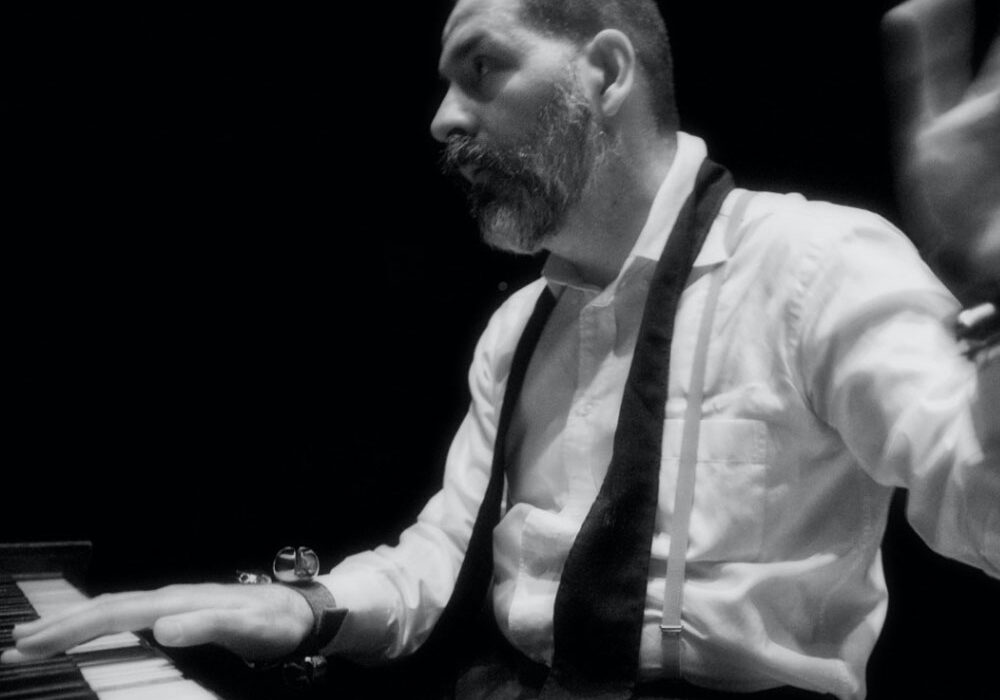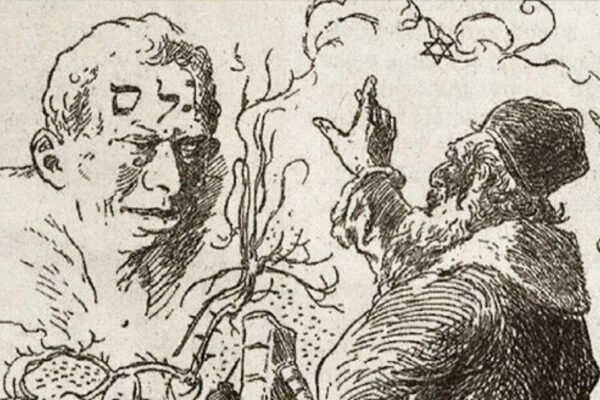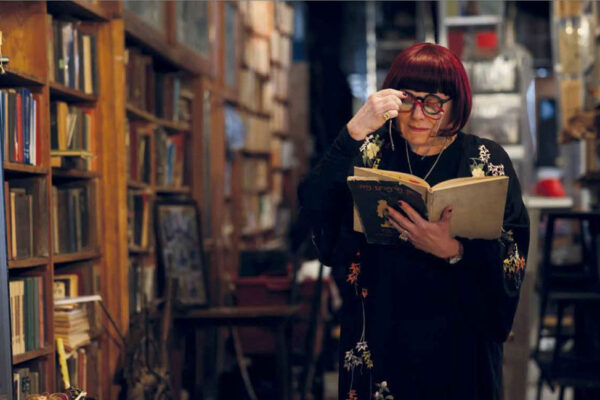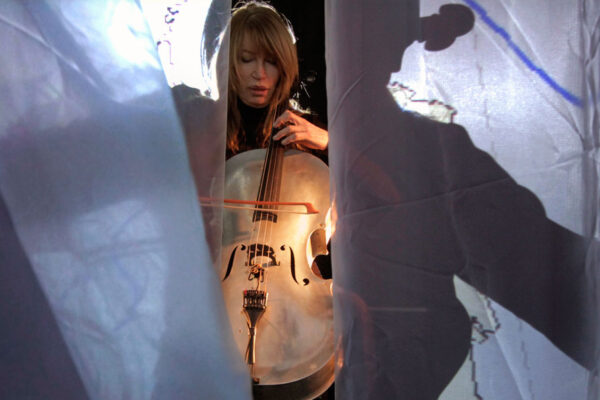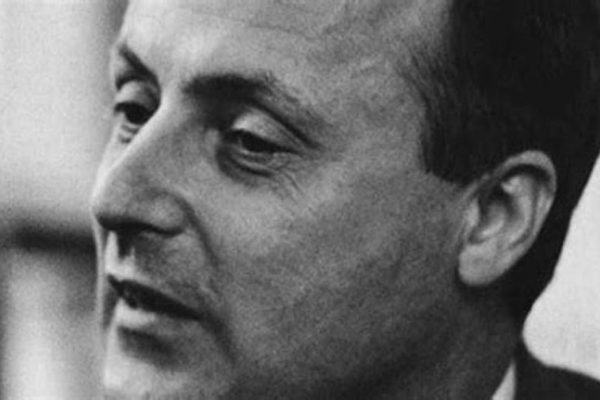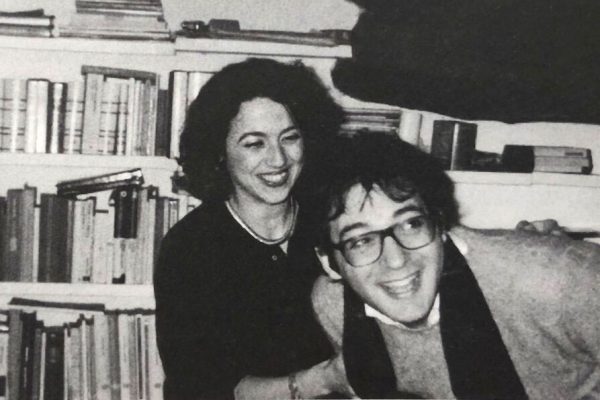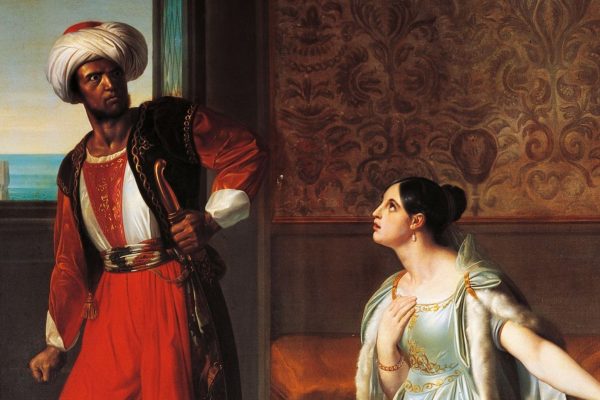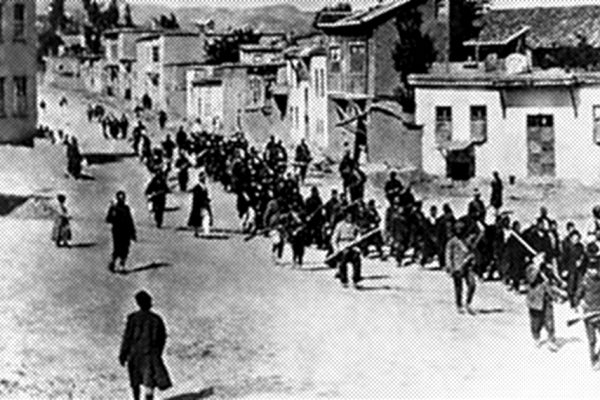Alessandro Cassin is the director of Centro Primo Levi’s online magazine, Printed Matter and CPL Editions which published over 15 books since its debut in 2014. Coming from a tradition of publishing —his father published the first edition of If This Is A Man in English—Cassin began working in experimental theater and was awarded the Premio Ruggero Rimini 1989 for Il Presidente Schreber. He has been a cultural reporter for publications including L’Espresso and Diario. He is a contributor of The Brooklyn Rail. His book Whispers: Ulay on Ulay co-authored with Maria Rus Bojan received the 2015 AICA Netherlands Award. He coordinated the publication of Laurence Butch Morris’ The Art of Conduction edited by Daniela Veronesi (Karma, 2017). He is the author of The Scandal of the Imagination a film about the life and work of Aldo Braibanti ( 2021.) During the pandemic he wrote A Fiesole, bambino.
Alessandro Cassin: You do a lot of different things: you are a composer, conductor, instrumentalist, performing artist and, at times, visual artist. Can you attempt to explain how —music being the focus —all the different parts of your activities fit together?
Luciano Chessa: That’s something I have been asking myself for a very long time! There have been moments when I wondered if my different activities induce me to lose focus, but truthfully, I feel that as long as I enjoy doing different things — and I enjoy all of them immensely! — there is no harm. The hope is that the same strategies I employ when composing a piece of music are also found in, say, my installation work.
AC: Is there an element that ties the different kinds of creation you are involved with?
LC: It would have to be the handling of time. The vast majority of what I do is time-based work; however, what I learn from it applies even to works such as collage which is not directly related to time. Composition, a discipline I always understood as the art of placing aural materials in a specific order, is central in my work primarily because it allows me to work with time very directly. I believe that what I do is handling, molding, creating with—and in—time.
AC: Music occurs in time.
LC: Exactly. All the disciplines that I am involved in, from performance art to composition to improvisation, fill time in very specific ways. The idea of what to place on a time vector and when, this is central to my work. Years ago, Morton Feldman was asked, (I’m paraphrasing)”How do you compose? “And he said, “I pick the instrumentation” and paused. His students asked, “And then what?” Feldman answered, “That’s it!” For Feldman composing was, at its core, the mere consequence of choosing the instrumentation.He’d say: I need the color of the celesta, the color of the timpani played with soft mallets, and violas and cellos, but not violins or a trumpet…. In other words, Feldman was a composer of colors: when he’d decide the colors he’d want to use in a piece, the piece was basically composed. I feel similarly with time: once I decide the proportions of the various sections, I already have the piece. The actual pitch content is almost irrelevant, in a way. I am of course, exaggerating here to make a point, but I do believe that the length of each section and their placement within the overall structure of a piece, are basically the piece. Once I have decided that the final composition is a mere consequence: it almost writes itself. That’s why I’d say that my process has to do with the allocation of events in time more than anything else.
AC: How old were you when you realized your passion for music?
LC: Music for me became a necessity more or less when I was six years old. I started with humming… (he laughs!) Later, the piano became the vehicle to express my ideas; but my first recollection of sound-making is really my humming. Humming is so simple and private; you do it for yourself… and maybe not everybody likes your humming, but you do it nonetheless! Yes, I began by humming. The humming became many melodies, and it took on from there.
AC: Music is the most elusive and abstract of all arts. I am curious about how you found musical inspiration in literary texts. Over time you have worked on texts by Marinetti, Pasolini, Gertrude Stein, and now, Primo Levi. It is not apparent, for example, how an incredibly complex novel like Pasolini’s Petrolio can spark your musical imagination. Can you tell us about your experiences as a reader and how these experiences have triggered musical compositions?
LC: Thank you for mentioning those texts; there are many more on which I have worked: Ionesco, for example, has been somewhat of a fixation of mine.
In each case, I have proceeded differently. I am particularly interested in what I did with Pasolini’s Petrolio, which is similar to what I am doing with Primo Levi’s Piombo. It all begins with the emotional impact I experienced when reading the text. What follows is never an attempt to create an architecture that matches that of the literary work. With Petrolio, that would have been impossible both because of its complexity and length, and because it is unfinished, so we have no definitive author’s structure to follow (as I just said, the order of the material is essential, for me). There are all these folios whose order remained uncertain at the time of Pasolini’s death. We do not know if he had an intended order or was still searching for one. In any case, what we read today is a transcription of an unfinished work, with a tentative ordering: we do not know how close to what would have been his final intentions.
AC: How did you proceed?
LC: As a reader, I am interested in absorbing the emotion of a text, its emotional content more than narrative structural elements. And this is what I then try to communicate through my mediation in music. Of course, for a musician, there are other ways of using a text. For instance, if you are setting a poem to music, well, that is an entirely different process. In that case, the actual literary text is present. It isn’t merely referenced: it coexists with the music. But in the case of Petrolio and now of Piombo, what I did instead was to try to find within myself the kind of emotions that reading those texts had produced. I was aiming for a musical version of those very emotions. Something quite abstract. I don’t expect the listener to draw direct parallels. For example, when they hear a section of Petrolio, they cannot recognize it as deriving from a specific section of the novel, such as Il Pratone della Casilina, or anything like that.
AC: And in the case of Piombo?
LC: Piombo is not an unfinished text, so there is no speculation on the order of its parts. Still, this is irrelevant, as I prefer to impose my own structure to the music I am writing. In Piombo what stood out for me and stayed with me was the kind of writing: so impalpable, I would almost say magical… It took me several readings to actually figure out if the story was set in a specific time, and a specific place. It’s not immediately clear where and when the action takes place, nor what is actually going on: everything felt allegorical, in sharp contrast with other chapters of The Periodic Table. For instance, the opening chapter or story, Argon, despite its airy title, is the most grounded of them all, being a kind of “fabulous family genealogy”; Piombo, despite its greater physical weight, is not grounded at all: this is maybe what attracted me to it immediately. I did not know or imagine Levi capable of such a different register. I fell both for the story’s content and style.
AC: How did you encounter Piombo?
LC: It was Bob Weil (the executive editor at Liveright, responsible for the publication of Primo Levi’s Complete Works in English) who recommended I read The Periodic Table. I was familiar with If This is a Man and other Levi’s works, including TV scripts, but did not know this book. I am grateful to Bob for recommending it to me. Of course, when he did that, Bob didn’t realize that there was a chapter on Sardinia, my home region. When I read Piombo, it felt predestined.
AC: How did you go about writing music “about it”?
LC: The piece is not so much a recreation of the chapter as far as plot or structure, but rather it is an emotional recreation of feelings. Also, it is about my process of wonder within a narrative text, about my effort to come to terms with it and understand the text in a certain way. When is this happening, where is it set, is the story linear, or is it not? Is this the language of a chemist or is this the language of a shaman? The Levi of Piombo is not the analytical scientist we encounter in other of his writings, always penetrating even when describing the subtlest human emotions.
Here Levi abandoned the scientist’s tone and truly spoke the language of dreams.
AC: As readers, sometimes we need to let go of all expectations to really appreciate and learn from the unexpected in fiction.
LC: Exactly! I felt I knew what to expect from Primo Levi; instead, I found myself immersed in a kind of shamanic text. I surrendered to a sense of wonder; I fell both for the story’s style and content. For example, I had no idea what a mining prospector was. I learned that it is an explorer who studies and scouts lands searching for valuable mineral deposits.
I had no idea that there was a time in human history when people traveled to unknown countries and started to literally bite rocks with their teeth until they turned blue! In the Bronze Age, they did this to find specific metals… I was amused to read in an online geological resource site warnings not to chew on rocks (it’s dangerous; they can be toxic). Today there are many different tools to identify lead which do not require potential poisoning of the prospector. But at the time of Rodmund, the chapter’s protagonist, prospectors indeed bit into rocks. So, as I read the story, I also began to document myself on the world conjured in the text.
AC: You also mentioned being attracted to the fantastic travel elements in the story.
LC: Indeed. And that brought me back to when I was a student at the University of Bologna; I had the privilege of studying cultural anthropology with Ermanno Cavazzoni, a phenomenal writer in his own right, just a couple of years after Fellini released his last film (La voce della luna), based on Cavazzoni’s Il poema dei lunatici. His course focused on fantastic travel literature: we looked at, for example at Luciano’s La storia vera (A True History by Lucian of Samosata) —a text that fascinated Berio and I since we share our first name with the author— Gulliver’s Travels and other narratives about travelers encountering the most unimaginable and extraordinary populations, habits, circumstances, landscapes, foods and so on. I truly love the original way Primo Levi, in Piombo, pays homage to the tradition of fantastic travel literature. I was captivated by his description of the travels to Sardinia and the consequent description of the island itself: a bizarre place, where people do crazy things, and everything is just made with rocks. Rocks and rocks (in other words, a candy store for a mining prospector!) So Primo Levi with Piombo, reignited my previous interest in fantastic literature; I felt I was back in Cavazzoni’s class!
To summarize: I would say that my emotions in reading Piombo are linked with the excitement of search/discovery, which, in my own understanding of it, is at the heart of the story. I, as the reader, am conducting research, and so is Rodmund…
AC: How did this translate into music?
LC: I decided from the start that I would create a prolonged musical structure, mirroring the inquiry, which would end with what we can call a discovery. I wanted to communicate the emotive state of a search or a longing for something that we do, in fact, find in the end. I had to imagine how a listener would follow this particular itinerary. I had to plant into the path clues of what would fully manifest itself only at the end. In other words, create expectations which would make the listener desire to listen on and which make the listener feel fulfilled at the conclusion of the piece. I needed the end to feel precisely that: a rewarding arrival point.
AC: At what point of your process did you begin to think of the instrumentation and of this being a project in which you wanted to involve France-Marie Uitti?
LC: When I was reading The Periodic Table, I happened to be also speaking with Frances-Marie about the fact that the time had come for me to finally write something for her. We have known each other personally for about twenty years, but I was well aware of her work way before then. I had bought the now classic recording of Giacinto Scelsi’s Trilogy performed by Uitti and a student at the conservatory in my hometown, Sassari. I have known and admired her work for a very long time! Anyway, while we were concretely talking about a new piece for her, it occurred to me that a cello, particularly a cello expanded by her two bows technique — a cello plus— would be ideal for expressing what was forming in my mind regarding Piombo. As you know, her formidable technique greatly expands the possibilities of the cello: with the two-bows you can get an instrument that typically plays lines to play chorales. On a traditionally-bowed cello you can certainly play double stops, but you cannot get anything even remotely similar to what the 2bows technique can do. Frances-Marie has been perfecting it since the 1970s.
AC: How did you suggest this project to her?
LC: I told her about my experiences reading Piombo, and she immediately responded with such interest and enthusiasm that I knew we were onto something… She was familiar with other works by Levi. As soon as I told her about this one, she was eager to read it in the original Italian not to miss any of the nuances (her Italian is great. During the pandemic, she read Dante in Italian!) I remember that before she had a chance to read the text, we had great conversations on the element lead and about what came to her mind thinking about that metal, that concept. She reminded me of many different uses of lead including for the construction of bullets. Then, after she read the text, I began sending to her sketches of my composition as I was writing it.
AC: What were some of the issues you discussed during the process?
LC: The first issue was identifying the tuning for the instrument; we felt right away that a scordatura (re-tuning of the open strings) would open up possibilities. The practice isn’t uncommon: Bach used it in his fifth cello suite (the A string is tuned down to G), but also Mahler requires it for the concertmaster solo in the second “demoniac” movement of his Fourth symphony. He wanted the solo violin to sound like a fiddle, so he designed a folkish retuning.
Once Francis-Marie and I agreed on the scordatura, I decided to work backward: I first composed the piece’s very end. This allowed me to immediately give her the piece’s arrival point, and gave her… lead! That is to say, the complete final tune.
My composition process, I now realize, shares some similarities with the one Stravinsky adopted in his amazing Symphonies of wind instruments. Allow me to outline its history. Stravinsky had written a funeral chorale for his friend Debussy’s passing. Soon after he used this chorale as the foundation of a new piece for winds, in which the chorale is actually only heard in its entirety at the end. At first you get a characteristic Stravinskian treatment of it: a few chords of the chorale constantly interrupted by other materials: almost like a flickering from one world to another. Only in the end you get to be in the full presence of the chorale: and that moment is jarring. In Piombo I followed a similar procedure but without Stravinsky’s cinematic and aggressive use of fast flickerings and flashbacks. It’s funny: only now, as we are discussing this, it occurs to me that the idea of something that you only experience fully at the end came to me, completely unconsciously, from the Symphonies of Wind instruments.
AC: Back to the scordatura, can you tell me precisely what you chose?
LC: We were aiming at the kind of scordatura for the cello that would deliver that specific final tune to the fullest. For anyone curious, the non-traditional tuning we chose is C F#-C-and G, which produces very interesting sounds possibilities. The juiciest feature is the tritone between the fourth and third strings (definitely a noticeable color, very different from the traditional cello tuning by fifths). Playing in my head with the colors of this scordatura, in turn, generated new ideas.
AC: As you continued to send her parts of the composition, how did you collaborate?
LC: I would write sections, and she would try them. It’s not that she would suggest changing this or that note. Mostly I wanted to make sure that double bowing was possible on my score. Of course, my level of understanding of what is possible with her technique needed to be verified with her. I have written for cello (and strings) often, but this is quite a different experience. Frances-Marie surprised me all along: when we encountered a difficulty, she always came up with a way of solving it.
AC: How did you determined the length of the piece?
LC: I sort of followed Levi. In order to communicate the main idea of the piece, which is a difficult search for lead, it had to last at least 30 or 35 minutes. I wanted to render, musically, this search for lead, which, in Levi turns out to be also Rodmund’s search for that place of comfort where you can hang your hat and die.
AC: Piombo will have its world premiere at Magazzino Italian Art in a two-part program featuring Quest(o). Can you briefly explain what this will be?
LC: Piombo alone is not a concert-length piece, so in addition, we will create a more improvisatory piece called Quest (o) Una meditazione. For cello, piano, dan bau, and voices on words from Primo Levi’s well-known Ulysses’ chapter from If This is a Man (here too there is a search: while in Auschwitz Levi struggles to recall the Canto of Ulysses from Dante’s Divine Comedy). Frances-Marie will play cello with two-bows and I will play both piano and dan bau, a traditional Vietnamese single-string instrument I have been playing since 2007. The dan bau is the instrument I have recently been touring most because of its portability. I play the instrument with two magnetic resonators, making the string vibrate without touching it. I decided to use this technique in Quest[o] because it creates a kind of drone, ideal for the places where we alternate more musically active sections to the reading of Levi’s text. It’s a counterpoint; we did not want everything to be busy and full all the time.


